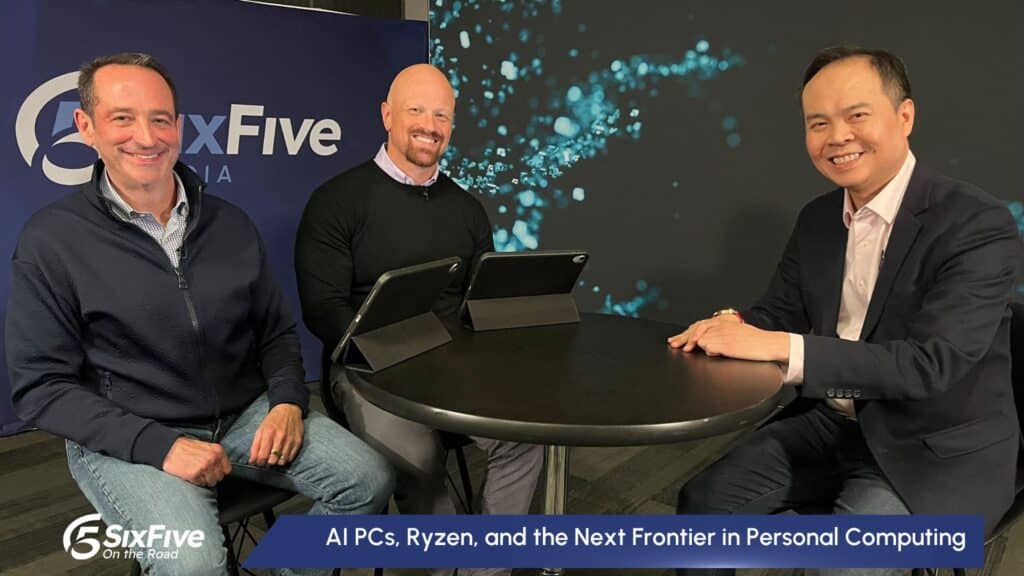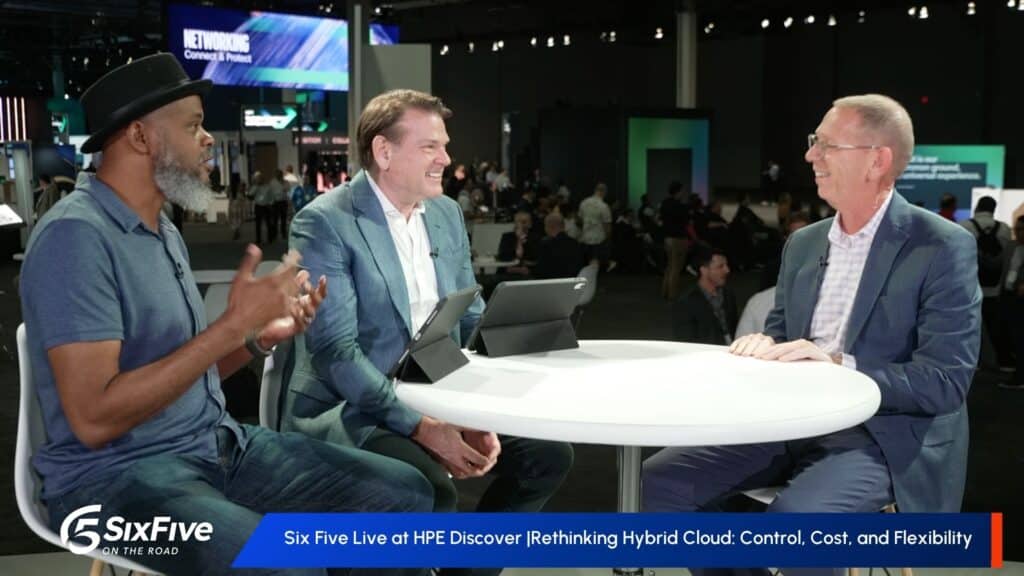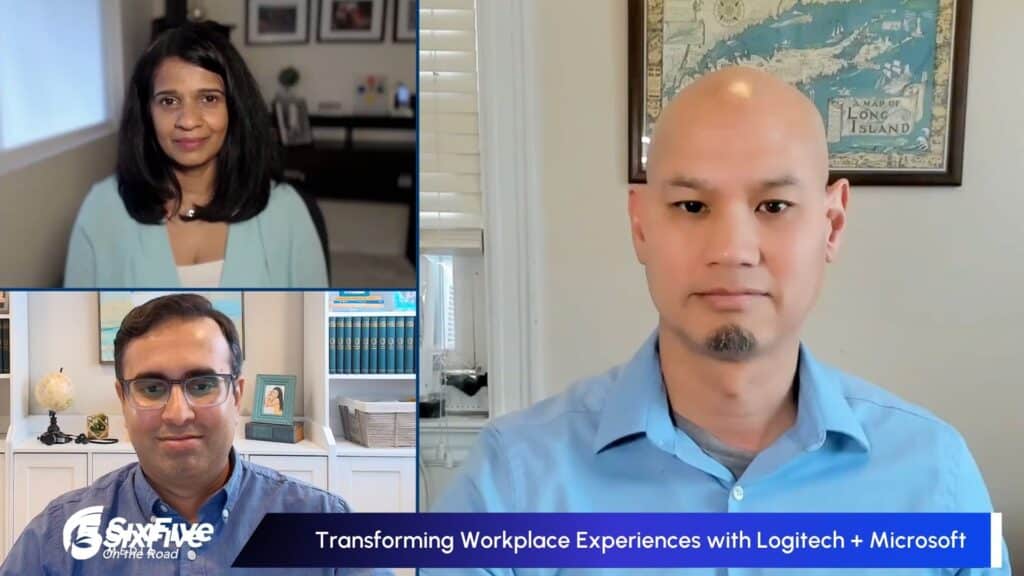The Oracle-AWS partnership is revolutionizing the way businesses migrate and modernize their Oracle Database workloads. 🤝 Hosts Daniel Newman and Patrick Moorhead are with Oracle’s Karan Batta, SVP, Oracle Cloud Infrastructure for Six Five On The Road at AWS re:Invent, to discuss the strategies and benefits behind this pivotal Oracle-AWS partnership, focusing on leveraging Oracle Database capabilities within the AWS cloud environment.
Their discussion covers:
- How Oracle and AWS aim to facilitate seamless migration and modernization of critical enterprise workloads into the cloud
- Insights into the upcoming Oracle Database@AWS service, and a sneak peek 👀 at its features and integration into AWS’s expansive cloud services
- The significance of the Oracle-AWS multicloud collaboration, focusing on offering customers flexibility, scalability, and enhanced efficiency
- Key differentiators that set Oracle Database@AWS apart from other multicloud initiatives
- Highlights from the recent announcement at AWS re:Invent, including Oracle’s ongoing efforts to enhance cloud interoperability and meet the evolving needs of its users
Learn more at Oracle Database@AWS
Watch the video below at Six Five Media at AWS re:Invent and be sure to subscribe to our YouTube channel, so you never miss an episode.
Or listen here:
TRANSCRIPT
Patrick Moorhead: The Six Five On The Road here at AWS re:Invent. It has been a great show so far, there is infrastructure, software, services and surprise, AI. But Daniel, as we have been saying for what, two years now, when it comes to enterprise AI, getting your data and data management in line, literally getting the data next to the compute and services, that is a must have for any of this AI goodness. For what it’s worth, any goodness anywhere.
Daniel Newman: Yeah, absolutely, Pat. It’s great to be back on the road here at AWS re:Invent. It’s always a big year, big show, lots to cover. It’s an infrastructure, choose your own adventure. And as you said, there is a lot going on right now in terms of how companies are getting all the data on-prem, in the cloud, and everywhere in between, in the right order to be getting access to all that compute goodness. That is a big theme here, no surprise, at this year’s re:Invent.
Patrick Moorhead: Yeah, it really is. And Dan, we throw around this 80%, 70% enterprise data is on-prem, but as we saw this year and throughout this AI journey, Oracle is making moves to get their database, literally, database service and hardware inside of multiple public clouds in addition to their own OCI. We’re here to talk about Oracle database at AWS, and we brought in the main guy who runs all of this stuff. Karan, welcome to Six Five.
Karan Batta: Thanks for having me. Appreciate it.
Patrick Moorhead: Yeah.
Daniel Newman: Yeah, it’s good to have you here, Karan. I am excited to talk to you about this. You heard Pat and I in the preamble, we’re both pretty enthused. This is a big infrastructure moment. I imagine this is always a big moment for you, not Oracle CloudWorld big, but a pretty big moment because AWS is, of course, one of the biggest infrastructure players out there and a lot of Oracle runs on AWS, and that’s been something you’ve been really focused on. Of course, you’ve announced this year, maybe it was earlier in the year, I’m trying to remember the exact timing. And Pat and I said, Hell-eth has frozen over ith.
Patrick Moorhead: Yes.
Daniel Newman: First, because I don’t think everyone necessarily expected and now you can-
Patrick Moorhead: Yeah.
Daniel Newman: … see though … go ahead, Pat.
Patrick Moorhead: No, no, I’m sorry. I actually used that term on CNBC where you had Matt Garman and Larry Ellison on stage, and I actually used that term. Sorry-
Daniel Newman: No, I was quoting you, that was not an accident. Karan, why don’t you start off talking a little bit about the catalyst there. What really drove OCI to develop this partnership with AWS and how are you thinking about this whole multi cloud approach?
Karan Batta: Yeah. No thanks. Firstly, thanks for having me. We are super excited. I think in a span of about 12 months, we didn’t think we would be here, but we are here. We snagged Azure about a year ago, actually to this day, in about a week’s time. It was our first region that we went on live with Azure, and then six months later we announced Google, and then at CloudWorld it came together in a perfect moment where we had Matt on stage with Larry and we talked. If you think about it, Larry hasn’t had anybody on stage for four decades. It was a fairly significant moment, I would say. AWS being sort of the leader in the space, of course, from a cloud infrastructure standpoint. It made absolute sense for us to partner with AWS. At the end of the day, I think, of course, we have a cloud and there are certain things that make our cloud better than others and not so much and so we can compare and contrast. But really, at the end of the day, a lot of customers have access to Oracle because their entire business runs in Oracle.
Whether they’re building an application, using some of our industry apps, whether in utilities or retail or financial or healthcare, or whether you’re running simply your data in a mission critical database in Oracle, whether it’s on Exadata or VM or using Rack or anything like that. Most customers critical data lives on Oracle technology. We don’t want to force customers to pick our cloud. We want to make sure that our technology is available to customers anywhere to pick it, even if it’s on-prem. We want to make sure that it’s a ubiquitous application of technology across anything. We should not be the reason why a customer certainly picks one cloud or the other cloud or whatever. There’s certain reasons why we think our database offering is better on our cloud, of course, but again, we’ve also tried to make sure that those sets of technologies also make their way into the other cloud providers. Which is why the reason we’ve actually implemented our database offering through other cloud providers such as AWS, is by actually placing a physical extension of OCI within the confines of an AWS data center.
Patrick Moorhead: By the way, that was the big, one of the emoji, head exploding when you did this with Azure because very infrequently will somebody allow anybody else’s infrastructure into their public cloud because the way that they design it is so dialed in. That was a big deal for me, so I think that is not only a testament to the power of the Oracle database, but also the power of Oracle Exadata at the same time. That was a huge takeaway for me. I remember just being on broadcast video and you try to explain the significance of it to somebody who’s not necessarily tuned in, but I think it did come through particularly, when you repeated it with Google and then AWS. I have to ask, what is different and unique about Oracle database at AWS from Oracle database at Google Cloud and at Azure?
Karan Batta: That’s a fair question. I think there’s a very nuanced, I would say, answer to that. In some ways, there’s nothing that’s different and in other ways-
Patrick Moorhead: Wait a second. Wait a second, that’s not what I was expecting.
Karan Batta: No, but that’s the thing, right, in some ways everything’s different. Of course, to begin with, the region availability is going to be completely different. There are customers that pick certain cloud providers for their particular region sets, and then there’s customers that have picked their regions on AWS that have a very different availability domain strategy, as an example. I think region differentiation is absolutely one. We talked at CloudWorld, actually, once we announced AWS, the fact that now, if you include all of the public cloud providers together, we are in well over 180 regions. That’s just unheard of. You can get Oracle technology anywhere in the world through any cloud provider and so I think region differentiation is going to be one. The second part of it is we are actually developing a very low interconnect between the footprint that goes inside AWS data center, our cage, our deployment of OCI, and directly in between the EC2 platform.
We’re developing a super low interconnect between our deployment within their data center to the rest of AWS platform because customers are going to run their applications on EC2 or other PaaS services. The kinds of applications that customers are developing on Exadata are extremely latency sensitive. There’s certain constructs that customers can use, whether it’s grouping of capacity, whether it’s low latency, and so we’re developing that low latency interconnect between the two sides. And then second, we are injecting a lot more integration into the broader spectrum of AWS, so for example, zero ETL. For example, you can move data around so that it’s directly accessible by other AWS PaaS services, whether it’s analytics, whether it’s other types of services, whether it’s AI.
So if you’re in Bedrock and you want to be able to access your Oracle data, you’re going to be able to pick your Exadata database and directly inject that data in and get intelligence out of it. There’s things like, for example, backups. We’re going to have default backups to S3. There are certain things that we are doing with AWS to make it much, much easier for customers to integrate their Oracle database, directly into the ecosystem of AWS services, which is why they picked AWS. I think from that perspective, it really comes down to the actual differentiation that AWS pitches. Now, going back to my earlier comment about everything is the same, the database offering itself isn’t going to be any different or better or worse. In fact, if anything, the value proposition of this offering is that the autonomous database service and the Exadata database service is identical, not just across AWS and the other cloud providers, but also OCI. It’s the same service.
Patrick Moorhead: Yeah. So net-net, you can standardize if you’re an enterprise. A typical enterprise has two and a half … I don’t know how you have two and a half cloud service providers, but it’s just an average … two to three, you can standardize an Oracle database, and then depending on which one of the public clouds or 2.5, you can then differentiate and leverage their services. You can leverage, for instance, their AI services and you can activate that data inside of that Oracle database.
Karan Batta: Yeah, the core constructs, right, joint support, joint operational cadence. Because again, this is an Oracle service at the end of the day, it’s still managed, run, operated by Oracle itself, but there’s a direct correlation between the AWS services and the Oracle side. You’re also able to use all of the benefits of having an Oracle contracts. So if you have a support contract with Oracle today, your usage on AWS through Exadata or autonomous database is directly applicable to your support reward. So you can essentially burn your support bill down to zero if you wanted to just by using your existing commitment on AWS.
Patrick Moorhead: Of course.
Daniel Newman: Karan, first of all, I really like the partnership, and I like the strategy from you and your team because I always thought it was sort of why play the make them choose game and take a part of the business, even if it sometimes ended up being more, when oftentimes it could be an and type of strategy. Of course, we all know that the cloud consumption or cloud economics is land and expand, so the better you service them, even if you want to eventually move them all the way onto the cloud, you’re still going to be better off getting them first. I thought that was a really sound strategy, it was good decision making, and I think it’s paying off.
Because basically you removed any isolationism where you’ve said to the customer, “It only works well this way.” Now you’re saying, “Choose your own adventure, whatever way you want to do, we’re going to work with you.” I think that’s great. Can we talk about this year’s re:Invent. Because obviously the announcement came earlier in the year, it’s building up, I’m guessing you’re starting to get a good sense of customer adoption, enthusiasm, excitement. What are you announcing here at this re:Invent as Oracle?
Karan Batta: First and foremost, it’s been absolutely incredible working with the Amazon engineering teams. I think the collaboration across the two organizations has been incredible considering our past histories across the two companies. I think super smart people across both ends of the spectrum and we’ve come together. We announced this thing in September. We’re already announcing limited availability in our first region, in East US, which is such a short amount of time between when we actually announced the partnership. Which as you can imagine, between two large companies, getting through all the legal and the paperwork and the negotiations, getting all that done to the point now where we’ve landed hardware and we actually have customers in preview running on our first region. I think that’s a very proud moment for both companies.
Basically we have limited availability in our first region across two sites, and we’ll expand and announce expansion of additional regions over the course of the next couple of quarters. I think that’s the big one. You can now simply go and launch an Exadata if you want to, and it looks like it’s a native service inside of AWS. It should look no different to other kinds of services that exist inside AWS. The purchasing mechanisms are all there, so you can go and essentially purchase or talk to your Oracle wrap or your Amazon wrap and purchase it through a private offer. And then you can just go ahead and start using an Exadata database.
Daniel Newman: Karan, just as a final question on the announcements and the progress of this, have you had any sense of the expediency of adoption, your limited availability? How quickly can you expand capacity? I know I saw Larry throwing out some pretty big numbers for his AI regions. How quickly can you build this out to support? Because there’s a lot of Oracle out there and a lot of Oracle out there on AWS infrastructure.
Karan Batta: Yeah, no, I think that’s a really good question. I think the thing is that we are where we are because of the investments Oracle’s put into our own regions. To slightly give you a little bit of context, we’ve been working on not just scale up, which is what you’re talking about with Larry’s AI infrastructure space where it’s like, “Hey, here’s how big of a cluster we’re making,” and that sort of stuff. But we’re also doing a scale down strategy, where we can fit a whole region in three racks, all of our 200 plus services, et cetera. What that means is we’ve invested in so much of a scale down strategy that expanding into another cloud provider isn’t very hard for us. It’s just another trial site deployment for us. We can literally take the Exadata’s, put a dark fiber, put it into their data center, and it just works. The work actually comes from the integration between AWS and Oracle to make sure that it’s seamless for the customer, where it’s just as simple as create an Exadata, create a PDB, create a CDB.
And all of the things that happen underneath the covers, where when you create an Exadata and you do a query, or you put the data in your database, all of those logs start flowing through CloudWatch and all these other different tools. That’s where all the work comes into play. Now, we have all those features available in limited preview now, but it shows you between September, and I guess now re:Invent. We’ve only had a couple of months to actually create all this work and do all of these things. I’m just really excited about the possibilities in the future of all the different types of integrations you could do on Oracle technology.
Daniel Newman: Yeah. No, this is great. Karan, I want to thank you so much for joining us here. I know AWS re:Invent is a busy event, and of course you’ve got a lot going on because you’ve got all the clouds to worry about and so much more leading OCI over there at Oracle. Let’s have you back on the show soon. We want to get an update from you on everything that’s going on, but thanks again and have a great re:Invent.
Karan Batta: Thanks for having me. Appreciate it.
Daniel Newman: And thank you everybody for being part of this Six Five On The Road. We’re at AWS re:Invent 2024. Hope you all had a good holiday, you’re back at it, lots going on. This is infrastructure. This is AI. This is so much more, but for Patrick and myself, it’s time to say goodbye. See you all later.
Author Information
Daniel is the CEO of The Futurum Group. Living his life at the intersection of people and technology, Daniel works with the world’s largest technology brands exploring Digital Transformation and how it is influencing the enterprise.
From the leading edge of AI to global technology policy, Daniel makes the connections between business, people and tech that are required for companies to benefit most from their technology investments. Daniel is a top 5 globally ranked industry analyst and his ideas are regularly cited or shared in television appearances by CNBC, Bloomberg, Wall Street Journal and hundreds of other sites around the world.
A 7x Best-Selling Author including his most recent book “Human/Machine.” Daniel is also a Forbes and MarketWatch (Dow Jones) contributor.
An MBA and Former Graduate Adjunct Faculty, Daniel is an Austin Texas transplant after 40 years in Chicago. His speaking takes him around the world each year as he shares his vision of the role technology will play in our future.





